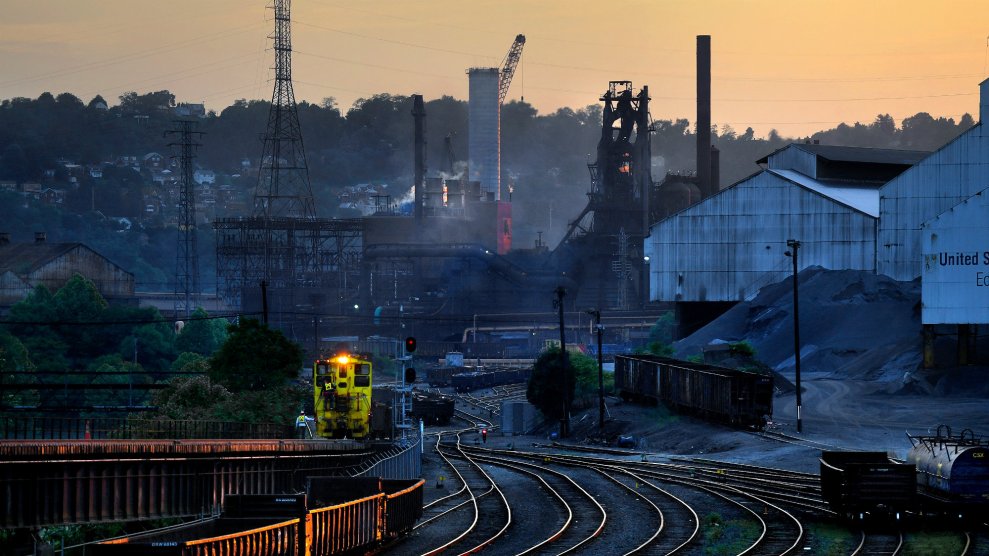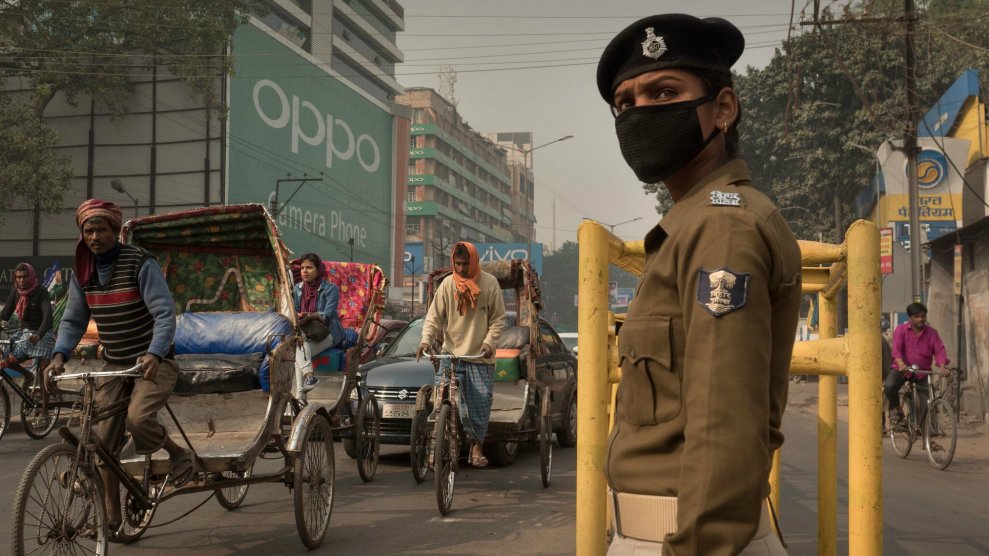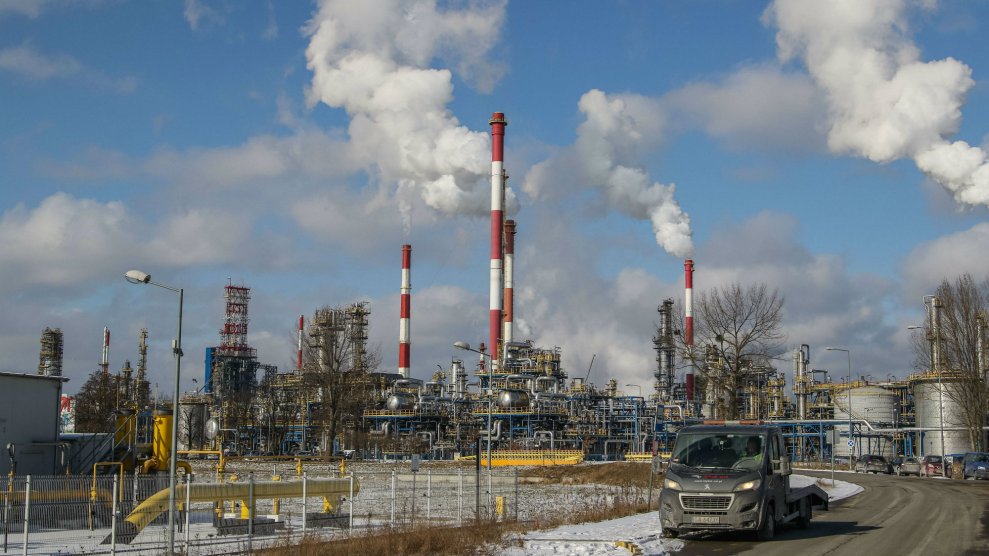
Michael S. Williamson/The Washington Post
This article was published by CityLab in collaboration with Topic and its new documentary series Braddock, PA, about residents fighting to bring their polluted steel town back from the brink. It appears here as part of the Climate Desk collaboration.
Where Braddock Avenue ends, after a patchwork of withering edifices, fading murals, and a few restaurants, there is a small, boxy green building with the name HOLLANDER’S plastered above its storefront windows. This was the name of a drugstore when, many decades ago, Braddock Avenue was a vibrant commercial corridor running through what was then one of the most prominent cities in America. Brandy Rawls is one of the building’s eight tenants, and she uses her space to run Oli’s Angels, an organization she launched last year to help expecting mothers with doula and midwife resources, and to provide bereavement counseling for mothers whose babies have died. Rawls herself lost her son, who was delivered stillborn in 2010, on Christmas Day.
Infant mortality is a devastating problem in Pennsylvania’s Allegheny County, where Braddock is located—between 2008 and 2012, white infants had average infant mortality rate of 4.75 deaths for every 1,000 live births, while the rate for black infants was 13.73. It’s an issue that perplexes public health researchers and reproductive rights advocates like Rawls. One suspected cause is the mill that sits directly behind her office, the Edgar Thomson Steel Works, which has been active since Andrew Carnegie opened it in 1872, and is now owned by US Steel. It’s a major reason why Braddock sits below some of the most polluted air in America, and possibly explains the area’s high rates of sickness. Over the past year, Rawls, who is black, has confronted a reality she can no longer ignore: If she wants to advocate for health in her region, she must learn to become an environmental activist.
Pennsylvania’s definition of an environmental-justice area is one that is upward of 30 percent minority and more than 20 percent low-income. Braddock qualifies as both. There are dozens of fossil-fuel power plants that are disproportionately located in census tracts where people of color are more than 30 percent of the population—and this is true for minorities at every income level, according to a recent report from the environmental watchdog group Food & Water Watch.
The reach and scope of Braddock’s toxicity is emblematic of what it means to suffer environmental injustice in the US, where people of color, and with limited resources, bear the brunt of pollution. The public health threats that come with carrying that environmental burden intersect with other urgent policy issues challenging the life and growth of Braddock, including the economy, schooling, and even reproductive justice.
In Braddock, the average median household income is $24,551, with 30 percent of Braddock’s population living below the federal poverty line—more than twice the rate for Pennsylvania. This is the economic condition that Brandy Rawls was in at the time of her own child’s death. She was born in Braddock and grew up there with asthma, eczema, and other allergies—all conditions that she says run through her family. Much of her Oli’s Angels work includes connecting mothers to agencies that offer things like free lead mitigation and air-filtration services for homes, all to keep the mothers healthy and better ensure that their babies survive. She is providing the kind of services she wishes had been available and accessible to her when she was pregnant.
Poverty concentration in and around Braddock
While she has been engaged in this reproductive-justice mission for the past five years, it was this past December when she learned about the environmental connection to her work. According to the World Health Organization, air pollution contributes to the leading cause of infant mortality, as well as to low birth weight and premature births. In Allegheny County, there is a huge disparity between black babies that have died due to below-normal weights and short gestation periods and white babies that have died under similar circumstances, according to the county’s health department report. Learning this, Rawls realized that her work would have to become even more intersectional than she originally planned.
“I really think that in order to improve birth outcomes in Allegheny County, we have to become more interdisciplinary and provide comprehensive education,” says Rawls. “As community activists, members, and professionals, we have to come together and bridge gaps. That’s the only way any of this is going to be effective.”
Concentration of non-white population in and around Braddock
Braddock is both running and dying on the fumes of steel, the primary source of both employment and smog in this small city of less than 2,000 people. The US Steel complex in the Monongahela Valley region is a sprawling ecosystem of manufacturing facilities located just outside of Pittsburgh, which include the Edgar Thomson mill in Braddock, the Irvin Plant in West Mifflin, and the Clairton Coke Works. Throughout history, US Steel, which today has its official world headquarters in Pittsburgh, has produced the bulk of the materials used to build and fortify buildings (and weaponry) across the globe. However, the steel industry’s center of gravity had shifted overseas by the 1980s, when US Steel began shuttering many of its operations in the region, draining Braddock of its economic livelihood in the process.
The city that was once defined by its steely resolve is now defined by poverty and pollution. The region’s long legacy of pumping iron, steel, oil, and coal out of its mountainous terrain has extracted a huge toll on the lungs of the people living there—and the air hasn’t completely cleared despite a huge reduction in those manufacturing and extractive operations in recent years.
Air pollution concentration in and around Braddock
Yet, it’s been difficult to consistently hold these polluting companies accountable because the culture of steelwork is so ingrained in the identity of the greater Pittsburgh region. “If you throw a stone you’re going to hit someone who worked in a steel mill like my father did briefly. And my grandfather and my great-grandfather spent their whole working careers there,” says Jamin Bogi, the policy and outreach director for the Group Against Smog and Pollution (GASP), which has been advocating for cleaner air policies in Pittsburgh since 1969. “Yes, it was amazing that our steel won World War II, but we also know that the air pollution shortened our lives by 10 or 20 years, and we know more now than we did then, so we can do something about it.”
The American Lung Association currently ranks Allegheny County 12th in the nation for year-round pollution from particulate matter—the particles of dust, soot, and smoke. When ranking Metropolitan Statistical Area, the ALA ranks Pittsburgh as eighth among all cities in this category, in its 2018 State of the Air report. A great deal of that particulate matter blasts regularly from the pipes and smokestacks behind Rawls’s office.
“I want these people to live,” says Rawls. “I want all these babies to live, and for these women to have good quality of life. I don’t want people to just get wet with a feeling of hope or change, I want to saturate the people.”
A culture ingrained in steel
Train yards run across Braddock and its neighboring towns, with locomotives transporting steel and coal materials, sprinkling extra layers of soot into the air from diesel engines. More diesel is spread from the trucks, boats, and barges that lug mounds of coal up and down the Monongahela River. (A few of those barges recently broke loose and spilled coal in the river near Braddock.) Toss in the elevated presence of lead from the many abandoned factories and mills, and the lead paint from old housing stock, and you have a cumulative toxic assault that makes Braddock one of the most polluted cities in a county that’s already considered one of the most polluted in America.
Lead paint risk rates in and around Braddock
Toxic air emissions are a way of life for the steel manufacturing industry. Government agencies permit steel companies to emit a certain level of air pollution that they believe is otherwise unavoidable. However, US Steel plants have regularly blasted out air toxicants beyond the permissible levels established by the county and federal governments. Last November, the Allegheny County Health Department and the US Environmental Protection Agency issued a joint notice to the steel plant in Braddock for “past and potentially continuing” violations of its permit for visible emission limits. The steel plant is not only a major emitter of particulate matter (the smog stuff), but also sulfur oxides (the funky-smelling stuff), volatile organic compounds (the liver-damaging and cancer-causing stuff), and carbon monoxide (the stuff that can silently kill you).
Braddock already suffers from some of the highest rates of respiratory disorders in the region. The asthma rates are so bad, and among black children in particular, that it has triggered a chronic absenteeism crisis in the schools. The county health department also issued a $1 million fine in June to the Clairton Coke Works plant, roughly 12 miles down the river from the Braddock steel plant, for frequently exceeding its toxic-emission permit levels.
GASP and the Clean Air Council sued the health department in July 2018, arguing that it is drawing millions of dollars from several funding programs for a new building-renovation project when that money is supposed to go toward projects that clean the air. GASP and other environmental groups that focus on air pollution work have been past recipients of grants from the fund. But as GASP’s executive director Rachel Filippini says, those grants have typically been in the thousands of dollars, while the health department is expected to spend $4.5 million for its new building.
“We certainly want them to have a quality staff working in proper facilities, but these are county facilities so this should be funded and maintained with [general] county funds, not by taking clean air money at a time where we have such terrible air quality,” says Filippini. “It’s an unprecedented amount of money that they want to take from this fund to do a project that will not result in cleaner air.”
The paradox of what’s happening in Pittsburgh
There’s even more urgency for clean air projects considering that there’s another pollution threat headed for the region: fracking. Last December, New Mexico–based Merrion Oil and Gas announced plans to develop six wells for hydraulic fracturing for natural gas on the Edgar Thomson steel mill site, taking advantage of the Marcellus Shale that runs through the valley. US Steel spokeswoman Meghan Cox told NPR that the company views “this project as a potential opportunity to enhance the long-term cost competitiveness of our local Mon Valley works facilities, including Edgar Thomson plant.”
Edith Abeyta and her North Braddock neighbors caught wind of the incoming fracking threat in 2014, and began organizing to stop it. They successfully lobbied their city council to pass a zoning ordinance that would ban fracking within its borders. (The city of Pittsburgh passed a similar fracking-ban ordinance in 2010, as did other small surrounding municipalities.)
But the site where Merrion Oil and Gas plans to build wells and drill, on the Edgar Thomson footprint, is in North Versailles, a small municipality that neighbors Braddock. Abeyta’s group realized this was close enough to them that they’d have to redouble their anti-fracking efforts, which they’ve been doing under the banner North Braddock Residents for Our Future.
There are risks from fracking operations that could further pollute the air and water of surrounding communities, hampering children’s cognitive and women’s reproductive abilities. A 2016 study linked exposures to the chemicals used for fracking to reproductive and developmental problems in female mice. Another study that year, based on an examination of the health of thousands of people living in Pennsylvania, found that the closer they lived to fracking operations the more likely they were to suffer from migraines and sinus infections.
“For me,” says Abeyta, “there is this paradox of what’s happening in Pittsburgh, not very far away where a lot of people and foundations and government officials are working to make the region more green and sustainable and livable. But then we have actions like this with fracking coming, and it seems like the antithesis of what’s happening in the rest the region.”
Abeyta has no background in environmental science, nor do most of the 100 or so members of this North Braddock collective. Like Brandy Rawls, they have become environmentalists out of necessity. “I just wanted to be involved in shaping the place where I live,” Abeyta says.













